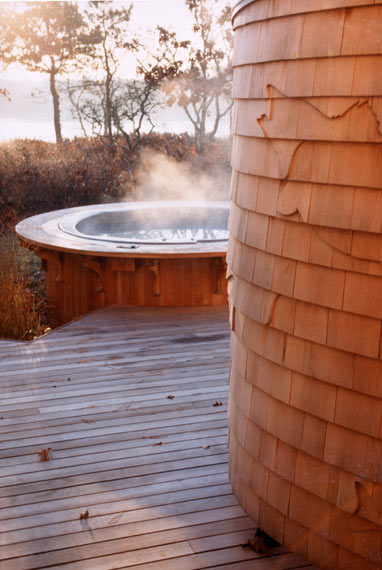By CARRIE GENTILE
What was originally born out of necessity has become an expected add-on in nearly all Cape homes.

Photographs Courtesy Jill Neubauer Architects
Over the years they’ve grown, been prettified, and in many cases, have been incorporated into the backyard landscape.
“They were lean and mean,” said Jill Neubauer principle architect of her namesake architectural firm in Falmouth.
“Now we want them to be bright and light…we are trying to have fun with them.”
Ubiquitous with Cape Cod living, the outdoor shower remains an integral part of a house, but with more thought into how they are built and designed.
Their benefits are alluring – mixing warm water with cool breezes as sunlight dances on your face, all while preventing the Sahara from forming in your kitchen.
She said traditionally they were practical dark boxes attached to the house.
“They were a spigot and walls,” she said.
They were used to keep the sand and insanity from numerous houseguests at bay, she added.
Now their popularity may be more nostalgia.
“People love the simplicity of them. What many want is to recapture the idea of summering on Cape Cod with their parent or grandparents, or what they are connected to,” she said.
Even though homes are built with more and bigger bathrooms, she said there is a presumption by her clients that a home here will have an outdoor space to shower.
Falmouth custom home builder and designer Thomas J. O’Neill echoed her thoughts.
“Without any exception, people expect there to be one.”

Photographs Courtesy Jill Neubauer Architects
“I’m sure it goes back to not brining sand into the house, but now they are an extension designing.
Popular are pergolas over the top for privacy, he said. And in general, they have gone from a 3-foot by 3-foot box to a 6 by 8 with a dry area to hang dry clothes.
Common features include peekaboos for privacy, hooks, a dry area, built in benches, a ledge for toiletries, separate hand-held sprayer for children, and a view, if possible.
Materials she works with are typically cedar or Douglas fir, with the floor a blue slate or a raised wooden pallet. Corrugated metal sides are popular as well, she said.
Mr. O’Neil said he’s using more composite bead board these days because it is easier to maintain.
Ms. Neubauer recently designed a shower reminiscent of a billowy blue and white circus tent. On another project, she hung cloth made from sails using grommets and hooks.
For a family with many children, she created off the shower two separate changing rooms – one for boys and one for the girls.
More often, she is designing them to be placed in the backyard alongside a fountain, or among trees.
“It’s fun to make it a bit of a destination,” she said.
But here is the dirty little secret of outdoor showers. Technically, they are illegal unless plumbed into septic.
When used for purposes beyond rinsing off after a day at the beach, outdoor showers violate Title 5 of the Massachusetts environmental law. Under Title 5, other gray water producers such as indoor showers and washing machines are permissible so long as they are linked to the septic system.
A high-end shower, replete with composite walls and stainless fixtures can cost between $4,000 – $6,000 to have installed and built, said Mr. O’Neill, adding they will add value to a home.
For the DIY-ers, he cautioned to make sure the ground has been prepped for drainage which may be a simple as digging up the topsoil to get to the porous sandy layer. Adding gravel on top is popular, topped off by a non-skid material such as the blue stone or a wood material.
Although they have grown through the years, the idea of an outdoor shower remains simplistic, Ms. Neubauer said.
“People are using them every day, beyond from just returning from the beach. It brings back the simplicity of a Cape Cod summer,” she said.

